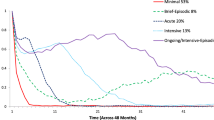Abstract
The growth of child and adolescent psychiatric services based on the wraparound philosophy raises new questions for medical directors, investigators, and clinicians interested in improving quality of care and outcomes. Typically, quality improvement studies have focused on standardizing care and decreasing variation while community based services following a wraparound model are by definition individualized. To date, little information on how to evaluate such services in a managed care environment has been available. We present one option for evaluating the distribution of medical services and the extent to which providers individualize services for children with severe emotional disorders. Specifically, we (a) review the philosophy and goals of wraparound services, (b) introduce the Lorenz curve as a tool for determining the degree of inequality in service distribution at a given institution, and (c) present a case study on the use of Lorenz curves by a Medicaid Behavioral Health Organization in profiling behavioral providers.
Similar content being viewed by others
References
Atkinson, A.B. (1970) On the measurement of inequality. Journal of Economic Theory, 2, 244–263.
Burns, B.J., & Goldman, S.K. (Eds.) (1999). Promising practices in wraparound for children with serious emotional disturbance and their families. Systems of care: promising practices in children's mental health., 1998 series, 4. Washington DC: Center for effective collaboration and practice, American Institutes for Research.
Chotikapanich, D. (1994) Techniques for measuring income inequality. Aldershort: Avebury.
Lee, W.C. (1996). Analysis of seasonal data using the Lorenz curve and the associated Gini index. International Journal of Epidemiology, 25, 420–434.
Lee, W. C. (1997). Characterizing exposure-disease association in human populations using the Lorenz curve and Gini index. Statistics in Medicine, 16, 729–739.
Lee, W. C. (1999). Probabilistic analysis of global performances of diagnostic tests: interpreting the Lorenz curve based summary measures. Statistics in Medicine, 18, 455–471.
MacLean, L.C. (2001). Resource absorption in a health service system. Health Care Management Science, 4, 337–345.
Russel, L.B., & Chaudhuri, A. (1992). The inequality of medical expenditures for several years in a healthy, nonelderly population. Medical Care, 30, 908–916.
Ryu, H.K., & Slottje, D.J. (1998). Measuring trends in US income inequality: Theory and applications. Germany: Springer.
Shryock, H.S., & Sigel, J. S. (1975). The methods and Materials of Demography, U.S. Government Printing Office, Washington. As cited in Lee (1999).
Toffalo, D.A. (2000). An investigation of treatment integrity and outcomes in wraparound services. Journal of Child and Family Studies, 9, 351–361.
Tresch, R.W. (1994). Principles of economics. St. Paul, MN: West Publishing Co..
Author information
Authors and Affiliations
Rights and permissions
About this article
Cite this article
Lewis, E.N., Nash, K.C. & Kelleher, K.J. Lorenz Curves: A New Model for the Distribution of Psychiatric Services. Journal of Child and Family Studies 12, 475–482 (2003). https://doi.org/10.1023/A:1026072209070
Issue Date:
DOI: https://doi.org/10.1023/A:1026072209070




